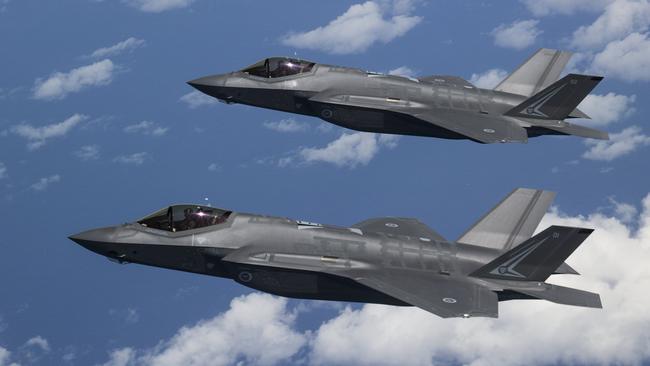Election 2025: Defence budget static as AUKUS costs soar, new analysis reveals
A new budget analysis reveals Labor’s claims to have massively increased defence spending are wildly overblown.

New budget analysis reveals Labor’s claims to have massively increased defence spending are wildly overblown, with real military funding barely keeping pace with inflation despite worsening strategic threats.
The evaluation by defence budget guru Marcus Hellyer says there has been no meaningful change to the funding trajectory since 2016 despite soaring capability costs that have seen expenditure on the AUKUS submarine program eclipse that for the entire air force.
It accuses the Albanese government of a “remarkably lackadaisical” effort that has left military spending languishing at just over 2 per cent of GDP, and Defence falling well short of its annual acquisition targets.
His findings will turbocharge the election contest on defence amid a political row over Russia’s bid to base military aircraft in Indonesia, and Donald Trump’s calls for US allies to spend at least 3 per cent of GDP on their militaries.
Peter Dutton, who is due to release his defence policy in coming days, claims the Albanese government has mismanaged the critical national security portfolio, and has vowed to spend more on military capabilities than Labor. But Dr Hellyer argues the failures are longstanding and not confined to one side of politics.

He said Defence was already dealing with a long-term erosion in its buying power that had been baked into its budget thanks to years of above-average inflation, with the shortfall to hit 7.5 per cent, or $3.8bn, a year by 2026-27 compared with 2019-20.
As the respected Lowy Institute poll reveals Australians’ trust in the US has plunged to its lowest level in two decades under Mr Trump, Dr Hellyer also warns Australia is becoming increasingly reliant on US military technology and needs to hedge against the risk of a less reliable and more demanding ally.
Of Defence’s top 30 acquisition projects, 63 per cent are primarily US systems, while 40 per cent of the department’s top 30 sustainment projects have significant US content.
Defence Minister Richard Marles said on Wednesday that Labor was delivering a huge funding boost for defence. “What we have already done represents the single biggest peacetime increase in defence spending in Australia’s history,” he said.
“Relative to the past, which is the only thing you can really measure against, this is a massive increase in defence spending that we’re engaging in right now.”
But Dr Hellyer said the Labor’s funding was already programmed into the budget under last year’s National Defence Strategy.
“Unfortunately, rather than seizing the moment, the government has only made minor tweaks,” the Strategic Analysis Australia research director said.
“Even Trump’s up-ending of the world order has made no difference to last year’s NDS plan, which increased 2024–25’s and 2025–26’s combined funding only by around 1 per cent.
“One wonders what it would take for the government to increase defence funding in the near term.”

The Coalition is weighing a plan to lift defence spending to 2.5 per cent of GDP, but multiple Liberal sources have warned it could take until the early 2030s to ramp-up to that level, given the opposition’s cost-of-living bidding war with Labor.
Under Labor, defence spending has hovered between 1.9 per cent of GDP and 2.1 per cent, and is forecast to rise to 2.33 per cent by 2033-34.
Dr Hellyer said this was “a remarkably lackadaisical ramp-up, particularly in comparison to what other countries facing strategic uncertainty have committed to”.
At the same time, the $368bn AUKUS nuclear submarine program has become the ADF’s “fourth service”, consuming a forecast $17.3bn over the forward estimates. The submarine program’s annual budget, at $3.5bn, has already exceeded that of the RAAF, at $2.5bn.
“Overall, while the situation might not be quite as extreme as Pakistan’s president Zulfikar Ali Bhutto’s statement that ‘Pakistanis would eat grass’ to get nuclear weapons, it’s hard to imagine a case in which Australia has pursued a single military capability with such single-mindedness despite the cost,” Dr Hellyer said.
His analysis reveals Defence is falling a long way short of its acquisition spending targets, meaning not enough new capabilities are being brought into service.

Defence should have lifted acquisition spending to 39.2 per cent of its total budget under a funding trajectory set in a 2016 white paper, but is forecast to achieve just 32.7 per cent this coming year.
“Defence hasn’t been able to hit its acquisition spending targets even before it attempts to deliver the more ambitious plan presented in the (National Defence Strategy). Over the past decade, it’s fallen short by a massive $26bn,” Dr Hellyer said. “Projects have taken too long to move through the capability development and delivery process.”
Meanwhile, sustainment costs are ballooning, growing by 74 per cent in real terms since 2016. Defence personnel costs have reclaimed relatively flat because its workforce numbers are hardly increasing.
Dr Hellyer’s Strategic Analysis Australia colleague, Michael Shoebridge, warned the slow ratcheting up of the defence budget came at a time when Australia faced added strategic risks because of the Trump administration’s unpredictability.
“America is no longer signed up to defending the global rules-based order and has little interest in helping its partners and allies to maintain a ‘free and open Indo-Pacific’,” Mr Shoebridge said.
“Now, American military power isn’t reliably available to partners and allies such as Taiwan, The Philippines, South Korea or Japan.
“Instead, any US military presence is likely to come with an increasingly large bill attached and without a solid commitment from the US government to act in common interests in times of crisis or conflict.”
Australian Bureau of Statistics figures released on Wednesday put the value of the Australian defence industry to the economy at $11.9bn in 2023-24, up 12.4 per cent on the previous year.




To join the conversation, please log in. Don't have an account? Register
Join the conversation, you are commenting as Logout